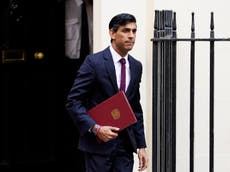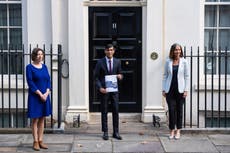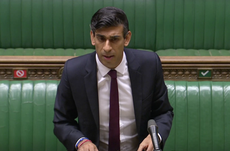Brexit negotiations end the same day as furlough – Happy Furloween!
On 31 October British businesses will likely be told no deal is coming this winter, just as the government stops the Job Retention Scheme

Your support helps us to tell the story
From reproductive rights to climate change to Big Tech, The Independent is on the ground when the story is developing. Whether it's investigating the financials of Elon Musk's pro-Trump PAC or producing our latest documentary, 'The A Word', which shines a light on the American women fighting for reproductive rights, we know how important it is to parse out the facts from the messaging.
At such a critical moment in US history, we need reporters on the ground. Your donation allows us to keep sending journalists to speak to both sides of the story.
The Independent is trusted by Americans across the entire political spectrum. And unlike many other quality news outlets, we choose not to lock Americans out of our reporting and analysis with paywalls. We believe quality journalism should be available to everyone, paid for by those who can afford it.
Your support makes all the difference.Chancellor Rishi Sunak has announced his new job support scheme to replace the job retention scheme (furlough) and help our economy bounce back. You’ve probably heard people talk about a V-shape recovery. That’s the idea that once we’ve dealt with coronavirus, because there’s nothing actually wrong with the world’s economy, we should bounce straight back.
Dear countries of Earth, raise your hand if when the pandemic is over, you’ll have just gone for no deal with your main trading partner? And given that the end of the Brexit negotiations is the same day that the furlough scheme ends… Happy Furloween!
Michael Gove recently announced that, from January, lorries will need an access permit to enter Kent and there may be queues getting to Dover of up to 7,000 lorries at any given time. I want you to think about that in relation to what CEO Stephen Phipson of Make UK, which represents UK manufacturing, had to say about the end of the furlough scheme: “When you bring manufacturing back, it’s not just flipping the switch. We have demand and supply-side challenges … On the supply side, it’s all about those supply chains, getting things across the borders, with all the restrictions that may be in place there, in order to get these factories working. So there will be a slow build-up to a recovery, and in that case, people will be on short-time working in certain sectors.”
In summary, maintaining UK jobs depends on unrestricted ports, and Cabinet minister Michael Gove says the ports will have significant restrictions. To add insult to industry, on 31 October, the day furlough ends, and millions of jobs depend on UK employers believing the economy is healthy enough for their business to thrive, those same businesses will likely be told to expect no deal this winter. Quick reminder, half of all UK-made cars, half of all the fish caught by UK boats, and a third of Welsh lamb is sold to the EU. No deal puts tariffs on all of that.
What I find interesting is that Sunak has this image of the cuddly conservative because he’s behind the schemes that give people money. But in the December election when pressed about whether we’d be at risk of a no deal this December, Sunak said “we’ll finalise the details next year”. He then chose to end the furlough scheme on the same date as the likely announcement of the no-deal he reassured us wouldn’t happen. And yet somehow, he’s seen as bringing stability to our economy?
Under Sunak’s new scheme employees of “viable” businesses who work a third of their usual hours will receive a maximum of 77 per cent of their pay, 55 per cent of which will be paid by the employer and the rest by the government. Unfortunately, that doesn’t cover businesses that simply can’t operate in this Covid-19 climate or businesses that don’t fancy paying their employees twice as much as the work they actually do, meaning they simply decide to lay them off.
A key question is: why aren’t more businesses “viable”? We knew from the start that lockdown doesn’t eliminate the virus or get us immunity. It just slows the spread so that the NHS isn’t overwhelmed.
Why didn’t the government focus on supplying restaurants and offices with the plastic partitioning and improvements in ventilation that would allow them to operate safely even during an infection surge? Why did the government use public money to increase the infection rate via the Eat Out to Help Out scheme instead of using that money to help businesses refit their establishments in a Covid-secure way? That would have helped with the V-shaped recovery.
Coronavirus isn’t the government’s fault, but everything they’ve done, from locking down late to letting Cummings get away with breaking the rules, ending furlough on the same day as the Brexit negotiations, violating the Withdrawal Agreement to make no deal more likely, failing to test, and spending money to increase the infection rate not slow it… it seems like the only thing they’re trying to level up is the chaos.




Join our commenting forum
Join thought-provoking conversations, follow other Independent readers and see their replies
Comments